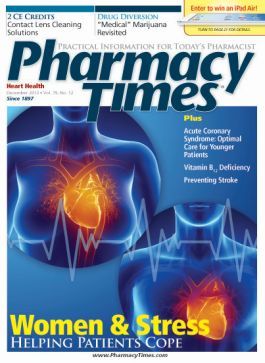Publication
Article
Pharmacy Times
Carboxylesterases and Drug Interactions


Carboxylesterase Enzymes
The cytochrome P450 family of enzymes is responsible for the metabolism of numerous drugs and is involved in many drug interactions. Carboxylesterases (CEs) are another family of related enzymes that promote the hydrolysis of endogenous and exogenous compounds. CE1 is the primary CE in hepatic microsomes, with a smaller amount of CE2 present. CE2 is the only CE found in human intestinal microsomes. As with other metabolizing enzymes, CE hydrolysis produces a more hydrophilic metabolite that is more susceptible to renal elimination. In addition, several drugs are formulated as prodrugs to enhance their gastrointestinal absorption. The prodrugs are then metabolized by CE to an active moiety.1
Clopidogrel and Carboxylesterase Activity
Clopidogrel is an antiplatelet drug that is often cited for its potential to interact with various CYP450 enzymes that are required to convert the parent compound to an active metabolite. However, 85% of the parent compound, which is inactive, is metabolized to inactive metabolites by CE1. Further, the active metabolite of clopidogrel is inactivated by CE1. The administration of drugs that inhibit CE1 would be expected to increase the response to clopidogrel. This could result in a further reduction in platelet activity and increased risk for bleeding. Ethanol, an inhibitor of CE1, has been noted to slow the metabolism of clopidogrel to its inactive metabolite. This effect could enable more clopidogrel to be converted by CYP450s to the active metabolite.2
Table: Examples of Substrates and Inhibitors of CE1 and CE2
CE1 Substrates
Prodrug
CE1 Inhibitors
ACE inhibitors except captopril and lisinopril
Yes
Clopidogrel
Clopidogrel
Ethanol
Cocaine
Isradipine
Dabigatran etexilate
Yes
Nelfinavir
Lovastatin
Yes
Procainamide
Meperidine
Methylphenidate
Mycophenolate mofetil
Yes
Oseltamivir
Yes
Oxybutynin
Simvastatin
Yes
Trandolapril
Yes
CE2 Substrates
Prodrug
CE2 Inhibitors
Acetylsalicylic acid
Ethanol
Candesartan cilexetil
Yes
Orlistat
Cocaine
Rivastigmine
Irinotecan
Yes
Olmesartan medoxomil
Yes
Prasugrel
Yes
Tenofovir disoproxil
Yes
Valacyclovir
Yes
ACE = angiotensin-converting enzyme; CE = carboxylesterase.
The related antiplatelet agent prasugrel is a substrate for CE2 in the intestine (Online Table). CE2 converts prasugrel into an inactive metabolite that is then converted into the active moiety by CYP450 enzymes. The effect of reduced CE2 activity on prasugrel active metabolite concentrations and antiplatelet efficacy is not known. Note that aspirin, commonly administered with clopidogrel and prasugrel, is converted by CE2 to an inactive (antiplatelet activity) metabolite, salicylic acid.
Modification of Carboxylesterase Activity
Clopidogrel is known to be an inhibitor of CE1. It has been reported to reduce CE1-mediated hydrolysis of oseltamivir to its active metabolite and decrease the antiviral effect of oseltamivir.3 Other CE1 inhibitors might reduce the efficacy of oseltamivir in a similar manner. Orlistat has been shown in vitro to be a potent inhibitor of CE2, but the clinical significance of this remains to be determined with in vivo trials.4
In addition, like several CYP450 enzymes, CE activity is genetically determined. It has been demonstrated that patients who have a loss of CE1 function due to genetic mutation produce more active clopidogrel metabolite (~60%) and have a greater reduction in platelet aggregation (29% vs 43% of baseline) compared with patients with functional CE1.
Associated with this increased magnitude of antiplatelet activity is an increased risk of bleeding.5 Genetic polymorphisms in CE1 activity have been demonstrated for several other substrates, including oseltamivir and methylphenidate. Genetic alteration in CE activity is likely to result in altered substrate pharmacokinetics and, perhaps, altered drug response.
Summary
Much more research needs to be done to identify substrates for CE1 and CE2. The effect of genetic polymorphism and the coadministration of inhibitors and inducers of CE enzyme agents need to be evaluated. It is certainly possible that some of the variation in therapeutic response observed with known CE substrates may be caused by interacting drugs or genetic alterations. Pharmacists should be aware of the potential interactions involving CE1 and CE2.
Drs. Horn and Hansten are both professors of pharmacy at the University of Washington School of Pharmacy. For an electronic version of this article, including references, if any, visit www.hanstenandhorn.com.
References
- Laizure SC, Herring V, Hu Z, Witbrodt K, Parker RB. The role of human carboxylesterase in drug metabolism: have we overlooked their importance? Pharmacotherapy. 2013;33:210-222.
- Tang MJ, Mukundan M, Yang J, et al. Antiplatelet agents aspirin and clopidogrel are hydrolyzed by distinct carboxylesterases, and clopidogrel is transesterificated in the presence of ethyl alcohol. J Pharmacol Experiment Ther. 2006;319:1467-1476.
- Shi D, Yang J, Yang D, et al. Anti-influenza prodrug oseltamivir is activated by carboxylesterase human carboxylesterase 1, and the activation is inhibited by the antiplatelet agent clopidogrel. J Pharmacol Exp Ther. 2006;319:1477-1484.
- Xiao D, Shi D, Yang D, Barthel B, Koch TH, Yan B. Carboxylesterase-2 is a highly sensitive target of the antiobesity agent orlistat with profound implications in the activation of anticancer prodrugs. Biochem Pharmacol. 2013;85:439-447.
- Lewis JP, Horenstein RB, Ryan K, et al. The functional G143E variant of carboxylesterase 1 is associated with increased clopidogrel active metabolite levels and greater clopidogrel response. Pharmacogenet Genomics. 2013;23:1-8.







